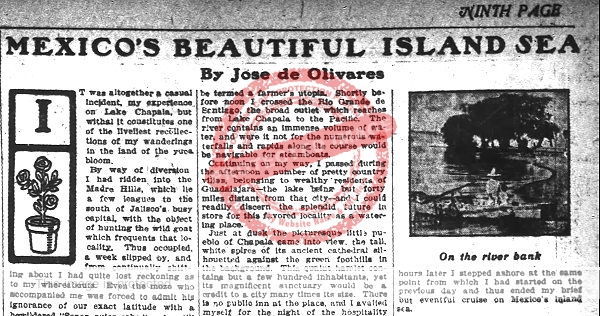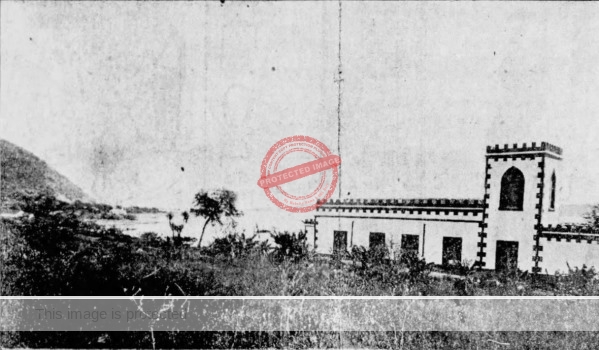In 1901, José de Olivares—author, poet and US diplomat—wrote a newspaper column about his adventures when visiting Lake Chapala. The column has several geographical inconsistencies which suggest that the author may have slightly embellished his real life experiences for dramatic effect.

Olivares opens his column by explaining how he first saw Lake Chapala after a week riding in the mountains south of Guadalajara hunting for wild goats, assisted by an invaluable but thieving mozo to look after their pack animals. Uncertain of their location, late one afternoon, as the sun was setting, they gained the crest of a high ridge and spotted “a vast sheet of water which stretched away from the range of hills… like a placid, billowless sea.”
Olivares is pleasantly surprised: “I had heard of this lake before… [but] my most generous ideas had pictured it as little more than a duck pond, and now it was revealed to me as a majestic inland sea.”
The two men rode down to the shore and bivouaced for the night near where the River Lerma empties into the lake. Olivares learns from his mozo that “at Chapala… some 60 miles to the westward, I could secure marine transportation facilities in any form from a canoe to a modern steamboat.” The following morning, Olivares set off at a gallop for the village of Chapala, leaving the mozo to follow at a more leisurely pace. He finally reached Chapala, after an enjoyable and scenic ride through beautiful agricultural country:
Just at dusk the picturesque little pueblo of Chapala came into view, the tall, white spires of its ancient cathedral silhouetted against the green foothills in the background. This quaint hamlet contains but a few hundred inhabitants, yet its magnificent sanctuary would be a credit to a city many times its size. There is no public inn at the place, and I availed myself for the night of the hospitality proffered me by one of the native residents.”
As a Navy man, Olivares very much wanted to hire a boat to explore the lake, but discovered that all the local boats were on the other side of the lake in Tizapan el Alto, which was celebrating a fiesta. Walking along the shore, he discovered:
“a dilapidated old shallop, long since consigned to “rotten row,” as naval parlance goes, but which I immediately set about to make sea-worthy. I calked her many seams as best I could, stepped a mast forward in her bow, and fashioned a rude pair of oars and broad sweep aft, in lieu of the regulation steering-gear.”
As soon as the mozo and cargo arrived and the boat was loaded, they set sail for Tizapan, where they spent the night. The following morning they set out for Jiquilpan. (Following the embankment and draining of the easternmost third of the lake in the first decade of the twentieth century, Jiquilpan is now far removed from the lakeshore.)
The first few hours of their trip towards Jiquilpan went smoothly, but in the early afternoon the wind suddenly changed direction, whipped up the waves, and threatened to blow them miles off course. “The mozo had completely lost his head and was upon his knees in the bow wildly crossing himself and calling upon his patron saint for deliverance,” when the boat capsized, throwing both men into the water. They managed to scramble onto the overturned keel of their vessel, but were well out of sight of any land.
Suddenly, out of nowhere, “a shrill whistle sounded close at hand” and they saw that a “small steamer was wallowing and diving toward us.” They were welcomed aboard and generously cared for by the captain, “who had sighted us by accident,” and a mere two hours later were safely back in Chapala, setting foot once again on terra firma.
The column was illustrated with several photographs (the number varied from one newspaper to another), with such captions as “On the river bank,” “Ancient Cathedral by the lakeside,” and “A country seat on Lake Chapala.” These photos are not known to have ever been published elsewhere, so they may well have been taken by Olivares himself. Another photo shows the Hotel Arzapalo still under construction and must date from 1897; the hotel opened the following year.

“A country seat on Lake Chapala” (Villa Montecarlo)
José de Olivares
The writer and Spanish-American War veteran best known as José de Olivares was born as Jesse Scott Oliver in Oxford, Ohio, on 26 November 1867. Olivares himself, much later in life, claimed on a passport application to have been born as José de Olivares (with the same November birth date) on his father’s estate in southern California.
According to Prabook (an unreferenced online Wiki for biographies), Olivares’s education included classes at the Liceo de Varones (Boys’ High School) in Guadalajara, as well as in business college and at the Berlitz School of Modern Languages.
As Jesse Scott Oliver, he enlisted in the US Navy at Mare Island in California in 1886, at the age of 18, while still technically a minor, and without “the consent of his parents or guardians,” an enlistment was contested unsuccessfully in a legal action the following year. Oliver (Olivares) was a member of the California National Guard (1884-1886), the United States Navy (1886-1893, and in the Spanish-American War of 1898), and the California Naval Reserve (1894-1896).
In 1897, “Jesse Scott Oliver… Los Angeles, Cal. deputy sheriff” was indicted in New York for attempted assault on a 15-year-old girl whom he had met at Coney Island. His counsel argued that he had done so while intoxicated, had since lost his job (and according to one account attempted to take his own life), and asked the judge for clemency. Oliver got off lightly with a fine of $150.
This event may have been the impetus to change his name and make a fresh start. From about this time, he used the name José de Olivares, perhaps to suggest a more personal Latin American background for his writing than the truth.
Olivares married Bertha Lillian Owen in Los Angeles on 2 November 1895, with whom he had two children, both born in California: Leonore Constance de Olivares (born in 1897) and Caspar Louis de Olivares (1901). His wife died when Caspar was only 3 years old, a few weeks after returning to San Francisco from Panama in October 1906. The following January, Olivares (stationed in Panama at the time) gave his marital status as “widower” when he applied for a passport for himself and his children. The following month he married Nicaraguan-born Maria Teresa Ramírez y Jerez.
All of Olivares’ writing for US newspapers was either non-fiction or poetry. The subjects of his columns, some of them syndicated, included “California’s Curio Industry,” “Mescal. A Story of the Southwest,” Mexico’s War with the Yaqui Indians,” and “Daniel Boone’s Western “Palatinate.”
His best known work by far was Our Islands and Their People, published in two large format volumes by Thompson Publishing Company in 1899. This book, lavishly illustrated with hundreds of photographs and numerous color plates, gave readers detailed accounts of the lifestyles, customs and landscapes of the islands ‘acquired’ by the US following the war of 1898, including Cuba, Hawaii, and the Philippines.
Olivares was a correspondent for the 1900 Paris Exposition, and was made an official representative of the Saint Louis Exposition at the Pan-American Exposition in Buffalo (1901). He won medals for his work as Commissioner of the Saint Louis Exposition to Spain, Portugal and Latin-American countries (1902-1903) and as Commissioner to the Argentine Republic for the Louisiana Purchase Exposition (1904).
In 1906, Olivares was appointed US consul at Managua, Nicaragua; he also served in consular positions at Madras, India (1911-1914), Hamilton, Ontario, Canada (1915-1924), Kingston, Jamaica (1924-1929), and Leghorn, Italy (1929-1932).
Olivares retired on 30 November 1932, and died a decade later in Santa Barbara, California, on 30 September 1942.
Several chapters of Foreign Footprints in Ajijic: Decades of Change in a Mexican Village offer more details about the history of the artistic community in Ajijic.
Sources
- José de Olivares. 1901. “California’s Curio Industry.” The San Francisco Call, 7 March 1901, 4.
- José de Olivares. 1901. “Mexico’s Beautiful Inland Sea.” The Sunday Oregonian (Portland), 2 June 1901, 32.
- Los Angeles Herald: 17 April 1901, 11.
- Nebraska Legal News: 2 September 1905.
- Santa Barbara News Press: 1 October 1942, 1.
- The Brooklyn Daily Eagle: 5 August 1897.
- The San Francisco Call, 6 August 1897.
Comments, corrections and additional material are welcome, whether via the comments feature or email.
Tony Burton’s books include “Lake Chapala: A Postcard History” (2022), “Foreign Footprints in Ajijic” (2022), “If Walls Could Talk: Chapala’s historic buildings and their former occupants” (2020), (available in translation as “Si Las Paredes Hablaran”), “Mexican Kaleidoscope” (2016), and “Lake Chapala Through the Ages” (2008).
Wow–what a guy and character—sure loved this write up and info–